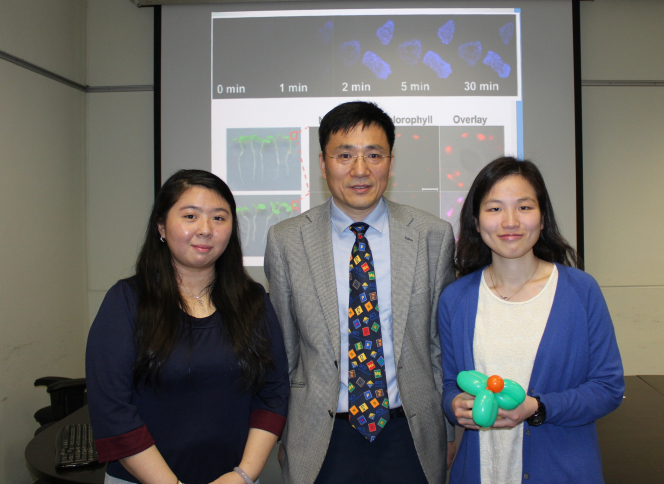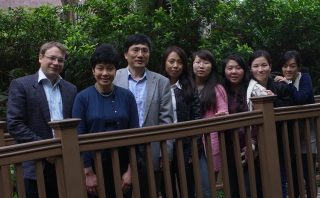Media
HKU Chemists develop novel fluorescent probe for monitoring cell activities to achieve breakthrough in future drug discovery
17 Mar 2015
(From Left) Dr. Angel Lai Yau-tsz, Professor Sun Hongzhe, and Miss Candice Chang Yuen-yan, of the Department of Chemistry
After three years of efforts, Professor Sun Hongzhe of the Department of Chemistry and his team of researchers, together with his collaborators in the Faculty of Science and Faculty of Medicine, the University of Hong Kong, are the first to develop the novel fluorescent probe that can rapidly trace the tens of thousands of tagged proteins inside cells. The findings were published in a prestigious international journal – Proceedings of the National Academy of Sciences of the United States of America. This unprecedented strategy of designing fluorescent probes reported by Professor Sun’s team has filed the patents from the US and Europe.
Scientists have been searching for ways to observe the location of tagged proteins within the cell and to understand how this changes with time as the cell performs different functions. The HKU research team led by Professor Sun provides quick labeling of tagged protein inside cells (in min) for observing the precise localisation of proteins for studying their functions in all types of cells, from bacterial cell to mammalian cells and even to highly complex plant tissues. The new fluorescent probe provides an inexpensive and effective tool for real-time monitoring of cell activities. It may be used to visualise the invasion events of pathogenic microbes and to analyse the actions of drug on its target, to assess the effectiveness of target drugs on cancer cells, and to trace and understand drug resistance in bacteria etc.. It will facilitate drug screening for future drug discovery, in particular the development of more effective target drugs. The fluorescent probe may also be applied to agricultural advancements in developing plant species with favorable genetic variations.
Scientists frequently use genetic modification so that proteins of interest can be marked for purification and/or observation.
One such tag, termed a hexahistidine-tag (His-tag), has been used for many years because it is simple and has minimal effect on perturbing the natural functioning of a protein of interest. Large libraries with tens of thousands of proteins each individually encoded with this small tag have thus been developed in recent years. The next question becomes – can we observe where each of these proteins is within the cell and how this changes with time as the cell performs different functions?

The fluorescent probe can rapidly cross the cell membrane in minutes and emit blue fluorescence only after labeling the target protein in cells. Hence, any actions that cause the movement of proteins in cell can be closely monitored.
To answer this question, Professor Sun’s research team has developed a novel fluorescent probe to rapidly label
intracellular tagged proteins (in min) with a reduction to only one-fourth of the cost of current methods. Scientists have spent tremendous efforts to monitor this class of proteins in living systems but Professor Sun’s team is the first to have succeeded. Challenges include getting the probe across the cell membrane, ensuring the probe does not disturb the natural functions of the target proteins, and is not toxic to cells. After three-year of efforts, Professor Sun’s team has created, up till now, the only small molecule-based fluorescent probe that can achieve this aim and will help us understand the functions of tens of thousands of proteins in all types of cells, from bacterial cell to mammalian cells and even to highly complex plant tissues. Furthermore, researchers in the group have also developed probes with different colors to enable the observation of the precise localization of multiple proteins within the same cells simultaneously, which is critical to understand how proteins interact with one another. These probes can be readily applied to visualize the actions of drugs on their targets in cells in facilitating drug screening for future drug discovery. Such biotechnology will have a significant impact on our understanding of the proteome – the next frontier after the genome.
This project was supported by the Research Grants Council of Hong Kong, the emerging Strategic Research Theme (e-SRT) on Integrative Biology and the Wilson and Amelia Wong Endowment Fund in fostering our interdisciplinary collaborations.
Professor Sun Hongzhe
Professor Sun Hongzhe is a professor of the Department of Chemistry at the University of Hong Kong. His research focuses on the biological inorganic chemistry and inorganic chemical biology, especially in metallomics and metalloproteomics. Professor Sun has published a series of work in understanding the functions of metalloproteins and the mechanisms of actions of bismuth-based metallodrugs. He is also a recipient of the Crouch Senior Research Fellow and the Convenor of the e-SRT on Integrative Biology.
Professor Sun was recipient of the HKU Outstanding Research Student Supervisor Award in 2013, awarded in recognition of his excellence in teaching and research.
More information about Professor Sun Hongzhe and his research group can be found from their group’s webpage: http://www.chemistry.hku.hk/staff/hzsun/website2013/Labpage/Home.html
Paper
“Rapid Labeling of Intracellular His-tagged Proteins in Living Cells”
at Proceedings of the National Academy of Sciences of the United States of America
http://www.pnas.org/content/early/2015/02/18/1419598112.abstract
Proceedings of the National Academy of Sciences of the United States of America, referred to as PNAS, is an official journal of the National Academy of Science, USA. PNAS is one of the world’s most-cited multidisciplinary scientific journals, covering publications in biological, physical and social sciences. PNAS is now celebrating the 100th anniversary of establishment.
Chemical Labeling of Proteins for Fluorescence Imaging and His-tagged Protein Library
Chemical labeling of proteins is a technique to investigate the localization, functions and dynamic activity of target proteins in order to understand the biological events in living cells. Scientists have spent tremendous efforts to manipulate fluorescent labeling in studying cellular events. Although genetically-encoded tags (e.g. fluorescent protein-tag) can be readily expressed with target proteins inside cells, they possess potential in deleterious perturbation of protein functions due to their large size. Alternatively, small tag-based fluorescent imaging, utilizing synthetic fluorescent probe to site-specifically interact with short peptide-fused target proteins provides a solution. Successful small molecule-based fluorescent probes include biarsenical FlAsH and its derivatives which bind to the tetracysteine motif of intracellular proteins, and Ni2+-NTA-based probes which interact with the hexahistidine-tag (His-tag) on proteins.
His-tag labeling system has been widely applied in protein purification and elucidation of protein characterization for biological and biotechnological research owing to its advantage in monitoring cellular activities with minimal disturbance to the functions of target proteins. However, due to the constraints of poor membrane permeability of Ni2+-NTA-based fluorescent probes, tracking the large library of His-tagged proteins in living cells is still impossible.
It is, therefore, of great interest to construct membrane-permeable small fluorescent probes in real-time monitoring intracellular His-tagged proteins for the investigation of various cellular events in situ.
For press enquiry, please contact Ms Cindy Chan, Senior Communication Manager of Faculty of Science, at 3917-5286/ 6703- 0212 or by email at cindycst@hku.hk.
Professor Sun Hongzhe’s research team and his collaborators at HKU (from left): Dr. Julian A. Tanner (Dept of Biochemistry), Prof. Chye Mee-Len (Wilson and Amelia Wong Professor in Plant Biotechnology, School of Biological Sciences), Prof. Sun Hongzhe and his research group members from the Department of Chemistry: Dr. Li Hongyan, Miss Yang Ya, Dr. Lai Yau-tsz, Miss Chang Yuen-yan, Miss Chao Ailun



